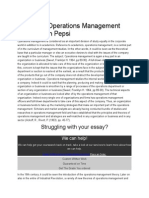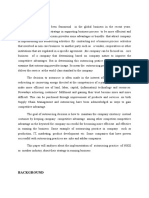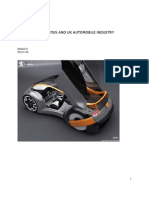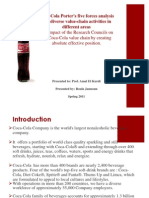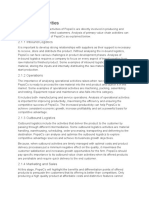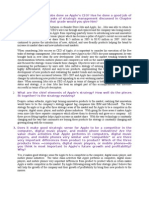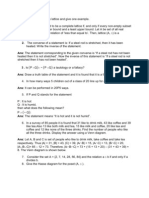Coke Pepsi Five Forces
Coke Pepsi Five Forces
Uploaded by
Ming EkpiyaCopyright:
Available Formats
Coke Pepsi Five Forces
Coke Pepsi Five Forces
Uploaded by
Ming EkpiyaOriginal Description:
Copyright
Available Formats
Share this document
Did you find this document useful?
Is this content inappropriate?
Copyright:
Available Formats
Coke Pepsi Five Forces
Coke Pepsi Five Forces
Uploaded by
Ming EkpiyaCopyright:
Available Formats
Porters Five Forces In Action: Sample Analysis of Coca-Cola
Since its introduction in 1979, Michael Porters Five Forces has become the de facto framework for industry analysis. The five forces measure the competitiveness of the market deriving its attractiveness. The analyst uses conclusions derived from the analysis to determine the companys risk from in its industry (current or potential). The five forces are (1) Threat of New Entrants, (2) Threat of Substitute Products or Services, (3) Bargaining Power of Buyers, (4) Bargaining Power of Suppliers, (5) Competitive Rivalry Among Existing Firms. The following is a Five Forces analysis of The Coca-Cola Company in relationship to its Coca-Cola brand. Threat of New Entrants/Potential Competitors: Median Pressure
Entry barriers are relatively low for beverage industry: there is almost 0 consumer switching cost and very low capital requirement. There are more and more new brands appearing in the market with usually lower price than Coke products However Coca-Cola is seen not only as a beverage but also as a brand. It has a very significant market share for a long time and loyal customers are not very likely to try a new brand beverage.
Threat of Substitute Products: Median to high pressure\
There are many kinds of energy drink and soda products in the market. Coca-cola doesnt really have a special flavor. In a blind taste test, people couldnt tell the difference between Coca-Cola coke and Pepsi coke.
The Bargaining Power of Buyers: Low pressure
The individual buyer has little to no pressure on Coca-Cola The main competitor, Pepsi is priced almost the same as Coca-Cola. Consumer could buy those new and less popular beverages with lower price but the flavor is different and the quality is not guaranteed. Large retailers, like Wal-Mart, have bargaining power because of the large order quantity, but the bargaining power is lessened because of the end consumer brand loyalty. There are many kinds of energy drink and soda products in the market. Coca-cola doesnt really have a special flavor. In a blind taste test, people couldnt tell the difference between Coca-Cola coke and Pepsi coke. People are getting concerns of negative effects of carbonated beverages. Increasing number of consumers begin to drink fruit juice, lemonade and tea instead of soda products.
The Bargaining Power of Suppliers: Low pressure
The main ingredients for soft drink include carbonated water, phosphoric acid, sweetener, and caffeine. The suppliers are not concentrated or differentiated. Any supplier would not want to lose a huge customer like Coca-Cola.
Rivalry Among Existing Firms: High Pressure
Currently, the main competitor is Pepsi which also has a wide range of beverage products under its brand. Both Coca-Cola and Pepsi are the predominant carbonated beverages and commit heavily to sponsoring outdoor festivals and activities. As Coca-Cola has a longer history, it is advertised in a more classical approach while Pepsi tried to attract younger generation by using pop stars as brand ambassadors. Currently Coca-Cola slightly topped Pepsi as the possessor of the most U.S market share. There are other soda brands in the market that become popular, like Dr. Pepper, because of their unique flavors.
Coca Cola has an enviable track record and there are countless millions of costumers the world over and with its five forces strategy it has succeeded remarkably in differentiating its products. Learn more about Coke's Porter's Five Force Model right here on Bright Hub.
It Started as a Proposal
In the year 1979, Michael Porter belonging to the Harvard Business School, proposed a business plan based on the five industry forces to do a SWOT analysis. The aim was to help business enterprises enlarge their market share and augment their profit. Michael Porter's plan was to make organizations understand their competition strengths and weaknesses and then devise suitable mechanisms to overcome competition. The plan studies the combined strength of five different market forces to achieve profitability goals. Coke, based on the above model, designed its own strategies for product differentiation. This is how Coke's Porter's Five Forces Model
came into execution.
Why is it Required?
The five forces plan is to assess the status of the industry in the open marketplace. It goes into the nature of competition, examines the external threats and identifies the opportunities to achieve competitive advantage.
SWOT Analysis Tool
www.Mindjet.com
Get a free 30 day Trial of Mindjet and create easily Swot Analysis.
Ads by Google
Generally, business competition negates profits if the organization has no competitive advantage over its business rivals. When a competitor acts in a particular fashion and others respond to counter-balance it, the rivalry only gets keener.
Coke's Porter's Five Force Model - Need of Standardized Strategies
Coke recognized that designing products, manufacturing processes and marketing strategies are to be internationally standardized. These factors are dictated by the scales of economy of different countries and the imperative need for cheaper means of production. Thus, Coke studied the five industry forces to evolve its competitive advantage over Pepsi. As per Porters formula, Cokes Porter's Five Force Model plan was to differentiate its frontline Cola product from its chief rival Pepsi by adopting certain operational methods. To heighten its competitive advantage, Coca Cola applied the Porter's formula
Business Rivalry
The first aspect was the low business rivalry. The market was essentially shared by Pepsi and Coca Cola, with a combined market share of 80 percent. The fact is Coca Cola owns two of the three soft beverages in the market, has few competitors and constantly striving for international presence. The second was to consider the bargaining power with suppliers that can be rated as low. The role of Coca Cola was to primarily supply either sucrose or fructose and undertake the bottling work. Sugar is commonly available and can be bought in the open market. If sugar became overly costly, the company could buy corn syrup instead. They even bought this substitute earlier during the early 1980s. As a matter of fact, Coca Cola buys high fructose corn syrup as its ingredient inside U.S. and sucrose only in countries other than US.
Bargaining Power
The third pertained to the bargaining power that can be rated as medium. The main distribution channels are supermarkets, large scale retail chains, fountain sales, sales through vending machines and convenience stores attached to gas stations. The fact is vending machines, convenience stores and super markets have low bargaining power as there are not many alternates.
Sales and Brand Loyalty
Other channels like large scale retail chains and fountain sales which are situated in fast-food outlets have a marginally higher bargaining power. They buy in large quantities and thus expect lower prices. However, in real terms, this segment hardly contributes to meaningful profits for
Coca Cola. Likewise, the fountain sales are also in the nature of paid sampling with negligible profits. They more serve to promote brand loyalty among clients and not increased profits. Finally, to consider the possible threats of substitutes that may again be rated as low. There are quite a few reasons why the threat of substitute is low particularly against Coca Cola. The foremost of them is brand loyalty. Coca Cola has an enviable track record and there are countless millions of costumers the world over, who would never abandon the brand and other Coca Cola products. There is no denying that Coca Cola has succeeded remarkably in differentiating its products.
You might also like
- English Level Test - A1Document2 pagesEnglish Level Test - A1Thiago Franco100% (1)
- Dehydrator Manual 30001455aaDocument48 pagesDehydrator Manual 30001455aachaudharyv100% (2)
- Marketing Plan (Sample) - 360 Energy DrinkDocument25 pagesMarketing Plan (Sample) - 360 Energy DrinkSaiyed Fauzan Ali95% (75)
- Analysing Operations Management Problems in PepsiDocument8 pagesAnalysing Operations Management Problems in PepsiAnnerlynn Solano100% (2)
- Coca-Cola BCG MatrixDocument7 pagesCoca-Cola BCG MatrixWajid Ali92% (13)
- Implementation of Outsourcing DecisonDocument12 pagesImplementation of Outsourcing DecisonInney Sildalatifa100% (1)
- Marketing in A Global AgeDocument22 pagesMarketing in A Global AgeIrfan FafooNo ratings yet
- Porter's Five Forces: Analysis of Cement, Construction and Automobile IndustryDocument46 pagesPorter's Five Forces: Analysis of Cement, Construction and Automobile IndustrySourav Modi86% (50)
- Competitive Analysis Between Coke and PepsiDocument35 pagesCompetitive Analysis Between Coke and PepsiVarun Haldipur33% (6)
- Waring Pro Yogurt Ym350 ManualDocument20 pagesWaring Pro Yogurt Ym350 ManualLynda LoydNo ratings yet
- PEST Analysis of The UK Airline IndustryDocument3 pagesPEST Analysis of The UK Airline IndustryMohammed Alsahli100% (1)
- Assignment of 5 Porters ForcesDocument6 pagesAssignment of 5 Porters ForcesArslan Nawaz78% (9)
- Value Chain Analysis of PepsicoDocument13 pagesValue Chain Analysis of PepsicoShalini Das85% (13)
- Bowman's Strategies ClockDocument3 pagesBowman's Strategies ClockDolargh100% (3)
- Marketing Plan of Coca ColaDocument10 pagesMarketing Plan of Coca ColaHelpdesk80% (5)
- Ethylene Glycol Chemical Engineering Final Year ProjectDocument108 pagesEthylene Glycol Chemical Engineering Final Year Projectridzuwan rahimiNo ratings yet
- UK Automobile Industry - 5 Forces ModelDocument7 pagesUK Automobile Industry - 5 Forces ModelZahid197767% (3)
- Mcdonald Report NepalDocument33 pagesMcdonald Report Nepalginish120% (2)
- Presentation On ClarksDocument28 pagesPresentation On ClarksKamil Hasnain100% (2)
- Pepsico'S Operations Management, 10 Decisions, ProductivityDocument2 pagesPepsico'S Operations Management, 10 Decisions, ProductivityNica JeonNo ratings yet
- Case Study of McDonaldDocument2 pagesCase Study of McDonaldchristina choo100% (3)
- Apple Inc 2010 CaseDocument23 pagesApple Inc 2010 Case074132019100% (1)
- Apple Management Strategic Management Case StudyDocument15 pagesApple Management Strategic Management Case StudyJedNur Kusayin100% (5)
- Business Strategy AssignmnentDocument40 pagesBusiness Strategy AssignmnentTharushi100% (1)
- A Home Investment Decision Case Study BackgroundDocument4 pagesA Home Investment Decision Case Study BackgroundZahid Usman0% (1)
- Coca Cola Using Porters Theory 5Document5 pagesCoca Cola Using Porters Theory 5Tabitha Abie KargboNo ratings yet
- Assignment of Marketing Management: Topic: Porters 5 Forces Analysis For Soft Drink IndustryDocument6 pagesAssignment of Marketing Management: Topic: Porters 5 Forces Analysis For Soft Drink Industryanshu169No ratings yet
- 9 Candida Killing Smoothie RecipesDocument10 pages9 Candida Killing Smoothie RecipesdalvaNo ratings yet
- Year 6 English Paper 1Document13 pagesYear 6 English Paper 1Ati Mamora67% (3)
- Cost StructureDocument5 pagesCost StructureTREK APOSTOLNo ratings yet
- Coca-Cola Porter's Five Forces Analysis and Diverse Value-Chain Activities in Different AreasDocument33 pagesCoca-Cola Porter's Five Forces Analysis and Diverse Value-Chain Activities in Different AreasRoula Jannoun67% (6)
- OM Assignment PDFDocument35 pagesOM Assignment PDFOSHIN MALVIYANo ratings yet
- 4Ps Analysis of Pepsi and CocacolaDocument22 pages4Ps Analysis of Pepsi and CocacolaBrijesh Chandel86% (14)
- Marketing Midterm - Mohamed Serageldin - PEPSIDocument14 pagesMarketing Midterm - Mohamed Serageldin - PEPSIHossam SamyNo ratings yet
- Porters Five Forces Model Automobile IndustryDocument16 pagesPorters Five Forces Model Automobile IndustrySnehal Joshi100% (2)
- The VRIO Framework of Competitive AdvantageDocument30 pagesThe VRIO Framework of Competitive AdvantageFajri FebrianNo ratings yet
- Porters Generic StrategiesDocument6 pagesPorters Generic Strategiessaransh maheshwariNo ratings yet
- Holland & Barrett-HashaniDocument17 pagesHolland & Barrett-HashaniManasa Selamuthu100% (1)
- The Cryptms Group-V3 (1) 2Document16 pagesThe Cryptms Group-V3 (1) 2Kavita BaeetNo ratings yet
- Business Strategy by Usman KhanDocument21 pagesBusiness Strategy by Usman Khanustomy100% (1)
- Case Study NestleDocument5 pagesCase Study NestleRidwan Ridho PuteraNo ratings yet
- Value Chain of PepsiCoDocument3 pagesValue Chain of PepsiCoFasion InstaNo ratings yet
- Porter's Five ForcesDocument3 pagesPorter's Five ForcesDEVINA GURRIAHNo ratings yet
- Definition of CostingDocument22 pagesDefinition of CostingmichuttyNo ratings yet
- Case Analysis 6 "Struggling Samsung Electronics": MM 5012 Business Strategy & Enterprise ModellingDocument11 pagesCase Analysis 6 "Struggling Samsung Electronics": MM 5012 Business Strategy & Enterprise ModellingAziz Wimawan KuswanputraNo ratings yet
- Case 07 - Apple Inc in 2008Document3 pagesCase 07 - Apple Inc in 2008superrjew50% (2)
- Operation Management of Apple and SamsungDocument30 pagesOperation Management of Apple and SamsungShaila Mae ParelNo ratings yet
- Business Growth and Strategy Project FinalDocument59 pagesBusiness Growth and Strategy Project FinalSonali AgrawalNo ratings yet
- Marketing Management Final Exam Open BooDocument40 pagesMarketing Management Final Exam Open BooKRook NitsNo ratings yet
- Apple Inc. Strategic Management Implemen PDFDocument49 pagesApple Inc. Strategic Management Implemen PDFMunirNo ratings yet
- Porter's Five Force ModelDocument52 pagesPorter's Five Force Modelpranaybhargava100% (11)
- First Mover AdvantageDocument9 pagesFirst Mover AdvantageDanish Ahsan100% (2)
- Marketing AssignmentDocument23 pagesMarketing AssignmentMohan Raj100% (1)
- Coca Cola Business ScopeDocument13 pagesCoca Cola Business ScopeFawwad Asghar0% (1)
- Starbucks A Case StudyDocument30 pagesStarbucks A Case StudyHaresh Pandav92% (13)
- Starbucks Value Chain AnalysisDocument3 pagesStarbucks Value Chain Analysismachoplus100% (5)
- Operations Management BTT..315: Term PaperDocument5 pagesOperations Management BTT..315: Term PaperDouglas Kipkurui Chumba80% (5)
- Porter's Five Forces in Action: Sample Analysis of Coca-ColaDocument2 pagesPorter's Five Forces in Action: Sample Analysis of Coca-ColaKenVictorinoNo ratings yet
- Case Study-Coca ColaDocument4 pagesCase Study-Coca ColaRavi KanthNo ratings yet
- Company Overview Coca ColaDocument29 pagesCompany Overview Coca ColaHeran SiparaNo ratings yet
- Cola Wars ContinueDocument1 pageCola Wars ContinueFarrukh Ali UqailiNo ratings yet
- Porter's Five Forces in Action: Sample Analysis of Coca-ColaDocument3 pagesPorter's Five Forces in Action: Sample Analysis of Coca-ColaSachi SurbhiNo ratings yet
- Strategic Management: Rashi AnejaDocument17 pagesStrategic Management: Rashi AnejaRashi Aneja 2027455No ratings yet
- Coca Cola Situation AnalysisDocument14 pagesCoca Cola Situation AnalysisEhtiaz KarimNo ratings yet
- Coca-Cola Porters Five Forces-SWOT AnalysisDocument72 pagesCoca-Cola Porters Five Forces-SWOT Analysishahahakim50% (2)
- External EnvironmentDocument2 pagesExternal EnvironmentJerome PascualNo ratings yet
- A Funny Story The Curse of A BullockDocument1 pageA Funny Story The Curse of A BullockClaudia ReyNo ratings yet
- Dicrete StructureDocument125 pagesDicrete StructureVishal GojeNo ratings yet
- Per My Last Email - Juliana SmithDocument320 pagesPer My Last Email - Juliana Smithem.s1lly.m0nk3eyNo ratings yet
- Draft PDFDocument2 pagesDraft PDFAnonymous MNnoqtNo ratings yet
- E8 - CzasyDocument4 pagesE8 - CzasyJustyna JaroszewskaNo ratings yet
- Ricardo A. Navarro JR.: ObjectiveDocument3 pagesRicardo A. Navarro JR.: ObjectiveJhayar MyraNo ratings yet
- White Pumpkin FrittersDocument1 pageWhite Pumpkin Frittersanandkavi10No ratings yet
- Good Fortune MenusDocument4 pagesGood Fortune MenusnwaxNo ratings yet
- Revisão Das Aulas 01, 02 e 03Document4 pagesRevisão Das Aulas 01, 02 e 03Tonny FilhoNo ratings yet
- Wedding Cake GuideDocument12 pagesWedding Cake GuideSlim KanounNo ratings yet
- Tllon Artesian Drinks Menu 07082023Document8 pagesTllon Artesian Drinks Menu 07082023vmakeienkoNo ratings yet
- The Fat Loss Macro CookbookDocument19 pagesThe Fat Loss Macro CookbookMohammad Sheaito100% (1)
- Chapter 5Document11 pagesChapter 5HaithemNo ratings yet
- MD - Raza Wine and It's ClassificationsDocument3 pagesMD - Raza Wine and It's ClassificationsAnamta ZehraNo ratings yet
- 1st PU Maths March 2014 PDFDocument4 pages1st PU Maths March 2014 PDFPrasad C M100% (4)
- Food Trend 2019 PDFDocument32 pagesFood Trend 2019 PDFSharon FariaNo ratings yet
- Organic Food Market SEAsiaDocument45 pagesOrganic Food Market SEAsiaShawn Powers100% (1)
- Small Cold Plates Greens Meats & PoultryDocument19 pagesSmall Cold Plates Greens Meats & PoultryFarley ElliottNo ratings yet
- Periodical Test Q2 English 4 Melc BasedDocument7 pagesPeriodical Test Q2 English 4 Melc BasedEM Gina100% (1)
- Brain TeasersDocument72 pagesBrain TeasersShailuAzadNo ratings yet
- Form Inbound Outbound - BKBDocument1 pageForm Inbound Outbound - BKBmogu moguNo ratings yet
- Falling Into Darkness 10Document16 pagesFalling Into Darkness 10Ambreen MahmoodNo ratings yet
- Quantifiers ExercisesDocument2 pagesQuantifiers ExercisesCelindaNo ratings yet



